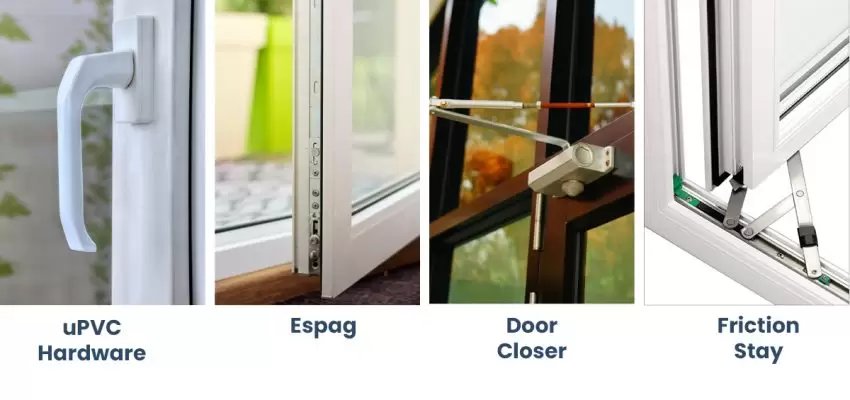uPVC (unplasticized polyvinyl chloride) windows and doors are popular with many homeowners due to their durability, energy efficiency, and low maintenance. An important but often overlooked aspect of uPVC products is the hardware – the hinges, handles, locks, and other fittings that allow the windows and doors to operate and secure properly.
Post your Requirement
Choosing hardware that matches the quality of your uPVC frames is key to getting performance and longevity out of the products. In this guide, we’ll cover the factors to consider when selecting uPVC hardware and show you how to match quality levels to your needs and budget.
Factors To Consider:
| Section | Key Points |
| Hardware Types and Materials |
|
| Performance Grade |
|
| Matching Hardware |
|
| Balancing Budget with Quality |
|
| Conclusion |
|
Section 1 – Hardware Types and Materials:
uPVC window and door hardware comes in a variety of types designed for different uses:
- Hinges – allow opening and swinging. Choices are butt hinges, flag hinges, and lift-off hinges.
- Handles – for opening/closing manually. Lever handle, knob handle, and pull handle options.
- Locks – provide security and ventilation: Espagnolette, shootbolt, latch, roller latch types.
- Friction Stays – restrict opening. Surface-mounted or recess-mounted.
- Load Bearing Hinges – support the weight of the door. Butt, lift-off, and flag hinge variants.
Most uPVC hardware components are made from aluminum, stainless steel, zinc alloy, or reinforced plastic. Stainless steel offers the best corrosion resistance and strength, while reinforced plastic provides good performance at a lower price point.
Section 2 – Performance Grades:
uPVC hardware is available in different performance grades indicating testing/certification to certain specifications. The grades to look for are:
- Ungraded – no standards testing conducted. Basic price point products.
- RAL-GZ 607/9 – German standard covering durability, corrosion resistance, and functionality testing. Mid-range performance.
- PAS 24:2016 – Strict UK Enhanced Security standard covering strength, forced entry, and impact/cutting resistance tests. High-security products.
- Marine Grade – Extreme corrosion resistance testing for use in coastal/salty environments.
Higher-grade hardware matches the longevity expectations of premium uPVC frames and multi-point lock mechanisms. Products tested to RAL, PAS 24, or Marine Grade will feature relevant certification marks like the British Kitemark.
Section 3 – Matching Hardware to Window/Door Types:
Compatibility with the frames and multi-point locks should guide your uPVC hardware selection for each window or door type:
- Casement Windows – Require 2-4 hinges (flag, butt, or lift-off types) and a handle/locking mechanism pairing tested to similar cycle/endurance grades.
- Sliding Windows – Compatible slimline handles, locks, roller latches, and recessed friction stays are designed not to interfere with opening/closing or impede narrow sliding sash paths.
- Front Doors – Robust multi-point locks with 3-5 deadbolts call for heavy-duty handles, cylinder pulls, letter plates, knockers, and spy holes supporting high-traffic usage.
- Patio Doors – Specialist double or triple transaction door sets combine high compression/security external handles with internal handles connected via rods/cables to operate lock points across the length of the sash.
Choosing hardware tailored to each door/window type ensures smooth operation, weatherproofing, and security without compromising aesthetics.
Section 4 – Balancing Budget with Quality:
Higher-quality commercial and heavy-duty hardware ranges offer the best functionality, security, and lifespans but come at increased cost. More affordable hardware still meets the functionality needs of most households if specified correctly.
Tips for balancing budget against quality/longevity include:
- Seek reputable mid-market brands offering longer warranties. Avoid ungraded budget lines.
- Use ungraded hardware internally where cosmetic wear is less concerning. Invest more in external hardware exposed to weathering.
- Spend more on hardware for ground floor/accessible windows and doors at higher risk of forced entry.
Following these guidelines allows tailoring hardware quality and budget across different products/exposures rather than a one-size-fits-all approach.
Conclusion
Choosing the right uPVC window and door hardware entails matching quality and performance grades to your requirements, environment, security risks, and budget. Seeking hardware designed for your exact product types ensures smooth operation, weather sealing, and security for many years before any maintenance is required. Investing a little more for higher graded external hardware exposed to harsh weather pays dividends in longevity and security.























Post A Comment